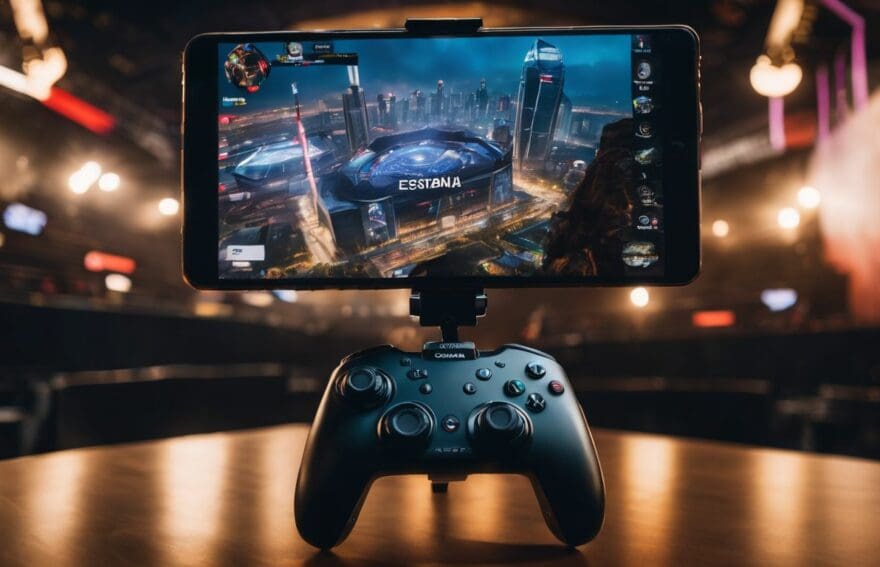Augmented Reality (AR) Applications in Esports Fan Engagement

Updated On: November 13, 2025 by Aaron Connolly
As passionate gamers ourselves, we’re no strangers to that feeling of longing—the yearning for a truly immersive encounter with the electrifying battles that unfold on our screens.
That deep-seated desire for a more gripping experience is something we’re all too familiar with; indeed, a striking 80% of aficionados are crying out for richer engagement. Our journey into the realm of Augmented Reality (AR) has uncovered not just an innovation but your ticket to becoming part of every heart-stopping esports instance.
Step into an AR domain where simply watching is transformed into an extraordinary adventure!
Understanding Augmented Reality (AR) Applications
Augmented Reality (AR) refers to the technology that superimposes digital information, such as images and sounds, onto the real-world environment. In the sports industry, AR has the potential to transform fan engagement by providing immersive and interactive experiences.
Definition and explanation
Augmented Reality (AR) brings digital excitement into our real-world environments, overlaying virtual elements onto our physical surroundings. Imagine you’re cheering for your favourite esports team and suddenly statistics, player profiles, and instant replays pop up right in front of you as if they were part of the actual setting.
This isn’t a scene from a sci-fi movie – it’s AR transforming how we interact with games.
This technology bridges the gap between virtual thrills and live-action sports. Not only does it enhance the spectacle for those watching at home or on their devices, but it also turns stadiums into interactive arenas where fan experience takes centre stage.
With AR applications, every moment becomes an opportunity to dive deeper into the gameplay and connect with esports on an unprecedented level. We’re talking about an immersive journey where boundaries blur and entertainment leaps off screens into our laps!
Its potential in the sports industry
Augmented Reality (AR) applications have immense potential in the sports industry. The technology is revolutionising fan engagement by providing immersive experiences that enhance live events, such as sports matches and esports tournaments.
Through AR, fans can access real-time statistics, behind-the-scenes content, and interactive experiences, allowing them to feel more connected to their favourite teams and athletes.
This not only excites fans but also presents lucrative marketing opportunities for sports organisations, as they can generate sponsorship opportunities and drive ticket sales through AR-enhanced experiences.
Additionally, AR offers authentic and scalable interactions with athletes, enabling fans to share their experiences on social media platforms while promoting the team’s brand.
Enhancing the Fan Experience with AR
Immersive fan experiences are revolutionising the way esports fans engage with their favourite teams and games. From live game enhancements to interactive experiences, AR is taking fan engagement to a whole new level in the world of esports.
Immersive fan experiences
- Unprecedented Access: Fans can virtually “step onto the field” and get exclusive behind-the-scenes views, enhancing their connection to the game.
- Interactive Elements: AR allows fans to engage with real-time statistics, providing an interactive and personalised viewing experience.
- Virtual Meet and Greets: Through AR technology, fans can virtually meet their favourite players, creating unforgettable moments for them.
- Social Media Integration: AR experiences enable fans to share their augmented reality encounters on social media, further amplifying the excitement and buzz surrounding esports events.
- Immersive Storytelling: Utilising AR, brands and teams can create captivating narratives that draw fans even deeper into the world of esports.
- Personalised Content: AR provides tailored content experiences that resonate with individual fan preferences, ensuring a truly engaging and personalised experience for every viewer.
- Enhanced Viewing Experience: With augmented reality, fans can enjoy highly immersive visuals that bring them closer to the action like never before.
How AR is Changing the Game for Sports Marketing
AR is revolutionising sports marketing by offering new opportunities for engagement and interaction with fans. These applications provide innovative ways to reach and monetise audiences, making it a game-changer in the industry.
Marketing opportunities and strategies
Augmented Reality (AR) provides new and exciting marketing opportunities for esports and sports industries. Its potential lies in offering immersive fan experiences, driving engagement, and creating unique sponsorship avenues. Here are some key opportunities and strategies for leveraging AR in sports marketing:
- Data-driven marketing: Utilise AR technology to provide real-time statistics, behind-the-scenes content, and interactive experiences to engage fans with a product or brand.
- Monetisation through AR: Explore the potential of offering branded AR experiences that can be monetised directly or through partnerships with sponsors, creating a new revenue stream for teams and organisations.
- Personalised fan engagement: Use AR to deliver personalised content and promotions based on fan preferences, creating a more tailored and engaging experience for each individual.
- Enhanced fan interaction: Leverage AR to facilitate interactions between fans and their favourite teams or players, such as virtual meet-and-greets or autograph sessions, fostering a closer connection between fans and the sports they love.
- Immersive advertising opportunities: Create innovative advertising campaigns through AR technology within sports venues or live broadcasts, providing brands with new ways to capture audience attention while enhancing the overall fan experience.
- Social media integration: Integrate AR experiences into social media platforms to allow fans to share their augmented reality interactions with friends and followers, amplifying the reach of the fan engagement initiatives.
- In-venue activations: Implement interactive AR activations within stadiums or arenas to offer fans an enhanced live event experience, encouraging them to participate in engaging activities related to the game or event.
Monetisation through AR
Sports organisations are leveraging AR technology to create new revenue streams. Brands can place targeted ads within the AR experience, reaching fans in a more engaging and unobtrusive way.
With real-time data tracking, sports teams can offer interactive sponsored content based on fan interests. This opens up monetisation opportunities beyond traditional advertising and ticket sales, driving revenue while providing valuable experiences for fans.
Moving forward to how AR is Changing the Game for Sports Marketing..
The Impact of AR on Live Sporting Events
The use of AR technology in live sporting events has revolutionised the fan experience, allowing for interactive and immersive stadium experiences. From real-time statistics to behind-the-scenes content, AR has transformed how fans engage with their favourite sports teams and players.
Stadium experiences
Augmented Reality (AR) technology is transforming the stadium experiences for esports fans in exciting ways. Here are some incredible ways AR is enhancing the live event atmosphere:
- Real – time statistics and player information displayed in AR overlays provide fans with deeper insights into the game, creating an immersive viewing experience.
- Interactive AR elements allow fans to engage with the environment, such as virtual scavenger hunts or interactive challenges during breaks in gameplay.
- Behind-the-scenes content delivered through AR allows fans to go beyond the surface of gameplay and connect with their favourite teams and players on a more personal level.
- AR-powered virtual meet-and-greets give fans the opportunity to interact with their favourite esports stars, creating memorable experiences for attendees.
- Augmented reality activations within the stadium contribute to a sense of community among fans, fostering a shared enthusiasm for the sport and its culture.
Fan engagement and interaction
Augmented Reality (AR) technology is revolutionising fan engagement and interaction in esports. Fans are now able to immerse themselves in the action through live game enhancements and interactive experiences, creating an unprecedented level of excitement.
Through AR, fans can access real-time statistics, behind-the-scenes content, and virtual meet-and-greets with their favourite players. This not only enhances the overall fan experience but also allows for more authentic and meaningful interactions with their gaming idols.
Esports organisations are leveraging AR to create immersive gaming experiences that go beyond traditional spectatorship. By providing fans with a closer connection to the action, AR technology is shaping the future of fan engagement in esports while opening up new opportunities for interactive experiences within the gaming industry.
Successful Examples of AR in Esports Fan Engagement
The implementation of augmented reality in esports has led to some exciting and innovative fan engagement experiences. From interactive AR overlays during live matches to behind-the-scenes content, there are several successful examples that have enhanced the fan experience in esports.
These case studies offer valuable insights into the potential for future growth and development in integrating AR technology into esports fan engagement.
Case studies of AR implementation in esports
Augmented Reality (AR) has revolutionised the esports fan experience with immersive and interactive elements. Here are some compelling case studies showcasing the successful integration of AR in esports:
- In a recent Dota 2 tournament, fans were able to use AR technology to view real-time statistics and behind-the-scenes content, enhancing their engagement with the game.
- The implementation of AR in a popular first – person shooter game allowed fans to interact with virtual reality elements, providing an unparalleled level of engagement during live events.
- A leading esports organisation utilised AR to create interactive experiences for fans, allowing them to virtually meet their favourite players and share their experiences on social media platforms.
- During a major esports championship, AR technology was integrated into live broadcasts, offering fans an enhanced viewing experience through real-time overlays and data-driven insights.
- Through the implementation of AR in virtual reality headsets, fans were transported into the gaming world, providing an immersive spectator experience that bridged the gap between virtual and physical reality.
Lessons learnt and potential for future growth
After analysing the case studies and successful examples of AR implementation in esports fan engagement, it’s evident that augmented reality has immense potential for future growth.
Lessons learnt from these implementations include the importance of providing authentic, high-quality, and immersive experiences for fans. Furthermore, leveraging AR technology to connect fans with their favourite teams and share experiences on social media led to increased engagement and excitement among fans.
The use of data-driven marketing strategies through AR also proved effective in driving fan interaction and interest in sports products.
Moving forward, there is great potential for growth in using AR technology to enhance fan engagement in live sporting events. Providing real-time statistics, behind-the-scenes content, and interactive experiences will continue to shape the future of fan interaction in esports as well as traditional sports.
Conclusion
Augmented Reality (AR) is revolutionising fan engagement in esports, offering immersive experiences and real-time interaction. Through AR technology, sports teams can drive fan excitement and create new sponsorship opportunities, enhancing the overall marketing landscape.
With the rising popularity of AR in sports, it’s clear that AR is reshaping the future of fan engagement by creating authentic connections and exciting experiences for fans at live events and beyond.
FAQs
1. What are augmented reality applications in esports fan engagement?
Augmented Reality (AR) applications in esports fan engagement use technology to create interactive experiences during live sports broadcasts and events, enhancing fans’ enjoyment.
2. How is AR changing the experience for eSports spectators?
AR changes esports spectator experiences by adding realtime statistics, behindthescenes content, and virtual elements that make watching games more immersive and engaging.
3. Can fans interact with live sports broadcasts using AR?
Yes! Fans can interact with live sports broadcasts using AR technology which adds layers of information and entertainment to their viewing experience.
4. Does AR offer benefits over traditional VR for Esports viewers?
Indeed, while Virtual Reality (VR) completely immerses users in a digital environment, Augmented Reality (AR) enhances the real-world setting of an esport event without isolating fans from their surroundings.
5. Are there any data-driven marketing opportunities through AR applications in Esports?
Absolutely! Through Augmented Reality apps tailored to esports fan engagement strategies, businesses can gather real-time data on viewer preferences and behaviors leading to targeted datadriven marketing opportunities.


